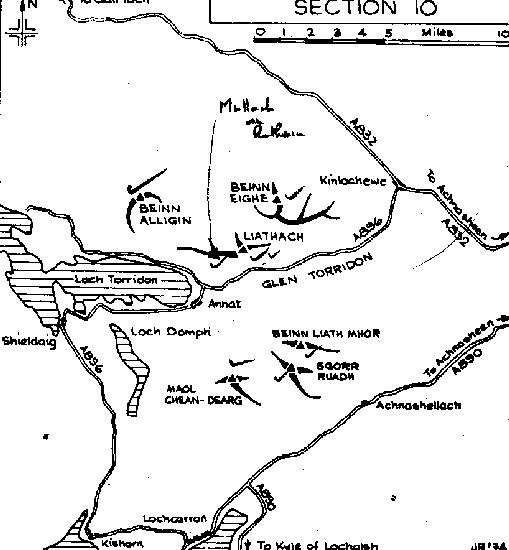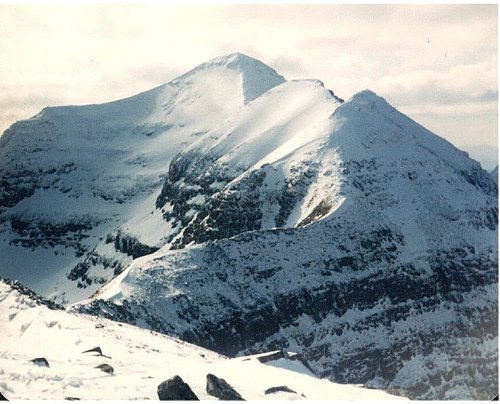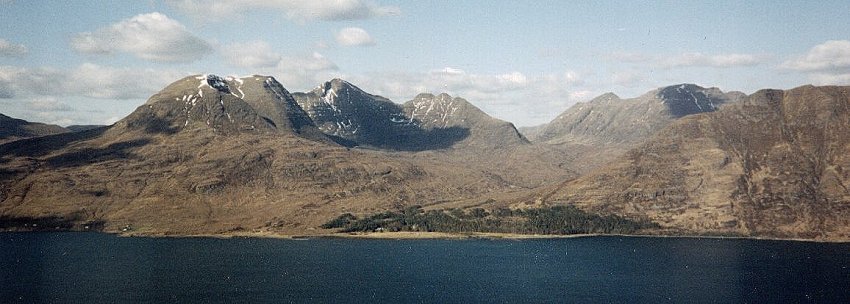

While the cluster of 4000ft peaks around Ben Nevis and their cohorts to the east around Cairngorm are the highest of the Scottish Munros - with Skye’s Inaccessible Pinnacle the hardest and A’Maighden in the heart of the wild Fisherfield Forest the remotest - the sheer-sided, multi-tiered, red-sandstone monoliths towering above the northern flanks of Glen Torridon in Wester Ross are surely the mightiest .

Munros of the Torridon Region of the NW Highlands |
Prior to my first visit to the Torridon peaks all hillwalks had been of the shortest way up and fastest way down variety - a large expenditure of time and effort for only a brief enjoyment of the summit view. It was on the great massif of Beinn Eighe that I was introduced to the delights of sustained, high-level ridge-walking - whole days on top of the world. The traverse of the sparkling-white, quartzite-capped tops along the narrow, crenellated crest and the excursion to the outlying main summit of Ruadh-stac Mhor is however a serious undertaking. As with other major ridgewalks it demands a high degree of commitment - once embarked upon there are few safe escape routes to the valley floor of the Allt a’Choire Dhuib Mhoir until the far end is reached.
Across the glen loom the great cliffs and buttresses of Liathach ( the ‘Grey One’ ) - the main contender for the title of the mightiest and most imposing mountain in Britain. The spectacular precipices of its eastern ramparts, best seen from Loch Clair on the approach to Torridon from Kinlochewe, rise dramatically from the surrounding moorlands giving Liathach an air of absolute impregnability and total invincibility.
 Summit
ridge of Liathach
in winter |
On an Easter ascent winter conditions still prevailed. Huge icicles, veritable swords of Damocles, threatened overhead as we cramponed, still stiff and moribund from a freezing cold night under canvas, up a snow-bound gully to reach the ridgetop. From the top of Spidean a’Choire Leith, the reigning peak, we looked over to Liathach’s second Munro of Mullach an Rathain at the far end of the ice-plastered arete. With its snow covered terraces separated by the multiple, horizontal bands of sandstone bedrock it resembled some gigantic wedding cake. Even in good summer conditions the traverse of the intervening ridge takes about four hours. The most sporting and interesting route is to scramble along the very crest of the pinnacles and gendarmes but ‘tourist routes’ are available to bypass the more awkward difficulties.
The third and most westerly of Torridon’s trio of mighty mountains is the three-horned Beinn Alligin. On a solo traverse of its convoluted skyline one damp and misty day I chose the wrong one of the plethora of paths leading from the last of the horns and found myself abruptly stranded above sensational vertical drops - it was a hard and tiring re-ascent to pick up the correct route. Emerging from the clouds on the final descent from Tom na Grugach a picturesque prospect unfolded of the blue waters of Loch Torridon framed by dark-green rhododendron forest.
 Beinn
Alligin, Beinn Dearg
and Loch Torridon |
Beinn Dearg, Torridon’s fourth sandstone monolith, only just fails to reach the critical 3,000ft benchmark but is still well worth climbing for its fine vantage point between Beinn Alligin and Beinn Eighe and the splendid views it affords of Liathach’s northern corries.
Only a short distance to the north of Glen Torridon lies An Teallach ( the 'Forge' ) a possible contender to Liathach for the title of Scotland’s mightiest peak. An impressive view of its jagged silhouette is gained from the Desolation Road ( an early social works project ) on the approach to Dundonnel for the normal starting point to traverse the castellated citadel - another long and strenuous outing - but one of the best of Scotland’s many ridge walks.
From the lofty summit of Bidean a’Ghlas Thuill - the first and highest of An Teallach’s ten 3000ft tops - a superb view unfolds of the assorted pinnacles, turrets and towers of the twisting, undulating spinal cord connecting to the second Munro of Sgurr Fiona.
Continuous scrambling is involved with some exposure and a head for heights is required - particularly from Lord Berkeley’s Seat with the immense voids below. Care has to be taken on the ‘Bad Step’ in descending Corrag Bhuidhe Buttress.
Sail Liath, the final top, provides a tantalizing climax with an extensive view across Loch Na Sealga into a vast wilderness area containing in its innermost recesses Scotland’s most remote Munros.
W.A.Poucher’s book 'The Scottish Peaks' emphasises that traversing the ridges on Beinn Eighe, Liathach and An Teallach is not the province of mere pedestrians. They are however ideal for fit and experienced hillwalkers to make the transition to fully fledged mountaineers. Unfortunately they are beyond a day trip from the central belt necessitating at least a long weekend.
Non Munro-baggers and those that don’t progress further north than Glencoe or Ben Nevis miss out on some of Scotland’s most memorable mountain experiences.
The Commentator, The ( Glasgow ) HERALD, Saturday 6th May 2000:
Southern Highlands :: Central Highlands :: NW Highlands :: Eastern Highlands
Site Index : Worldwide Mountaineering : Adventure Travel |